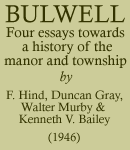III. FAMOUS BUILDINGS OF BULWELL
by W. MURBY
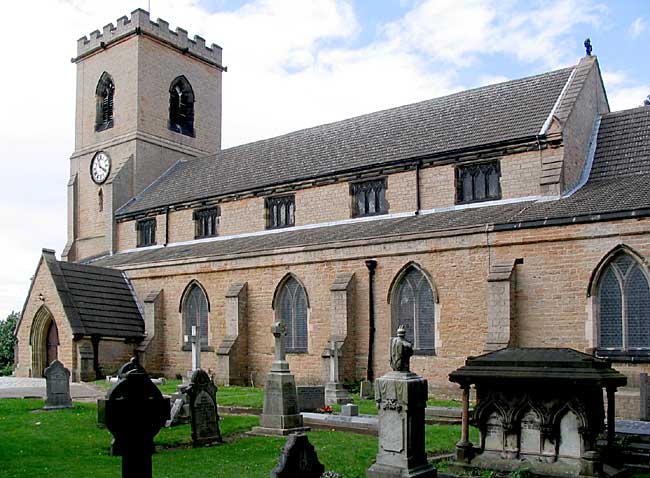
St Mary and All Souls, Bulwell was built 1849-50 by H I Stevens of Derby (photo: A Nicholson, 2005).
Let us stand for a while in our old market place and have a quiet look round. On the hill at the top of the bridge is our church, and what a crowd of recollections flood into the mind as we trace back its history! Our present church will shortly reach its centenary. Before we retrace in rough some of the particulars, we will take a look at its immediate surroundings. If there is anywhere in England a more concise village group of all a country village's requirements, I certainly do not know of it. Now for our suggested look round.
Nestling at the foot of the church, like a hen with her chickens, we have all the services necessary to the village life of over 800 years before the introduction of modern industrialism. Behind the church and down to the Leen would come the ancient Sherwood Forest. Within the small circle below, what a crowd of village life: the old rectory, the blacksmith's shop, the basket-maker, the brewery, the rectory farm, the old main road, the old bridge, the mill, the village pump and pillory, maltrooms, market, with farms, orchards and public houses. Let us go now into a few particulars dealing with this charming old picture.
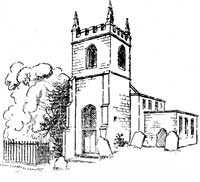
The old church at Bulwell.
There is a statement on record that our first church was a wooden one, built about the year 800 A.D. No real evidence can be found to prove this statement, but at the same time we are driven to the conclusion that it is mainly correct. Our present church is probably the fourth in succession, and a reliable estimate for the date of our second church is the year 1300. It would appear that Bulwell church is an ancient rectory belonging to the patronage of the Kings of England or of their lessees. The date of our first recorded clerk in holy orders is Henry Medicus (or Leech) of the year 1234. For the sake of remembering, connect with this date, 1234, Philip Marc, Sheriff of Nottinghamshire, Robin Hood, and Southwell Cathedral. Our present church register, owing to fire or carelessness, only takes us back to 1621, but other accounts are much older. A painting of our last church hangs in our present church; perhaps a few particulars about it would not be out of place.
In 1776, side aisles were added to the tottering old church; in 1800, the tiled roof was taken off, a slated roof put on and the tower restored. Fifty years later, it was entirely demolished and the present church built. Two bells which escaped destruction had a lodging in the churchyard for a while, and were then recast by Taylor of Loughborough, and are now included in the present peal. Nestling close to the church is the old rectory. The disuse of the main road which ran at its foot has given it a quiet seclusion: the traffic noises of our modern town are all round it, but its stately old-time charm is still retained. The coming of the railway took away the Rectory farm and broke off a section of old-time charm.
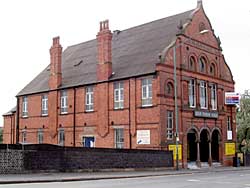
Bulwell Public Hall (photo: A Nicholson, 2005).
The public hall on the bridge is built, as you can see, over a set of maltrooms, and nearby is another old maltroom still standing. Anyone who is interested could spend a quiet hour reconstructing a number of these old buildings in the mind, so as to get a picture of the past. The old stone bridge has its date on the north side, "1833", with the initials "G.H." underneath the date. These initials stand for George Holmes, the builder, who was also the superintendent of the Baptist Chapel. Before the "new bridge" was built, the old bridge was very heavily worked, as all wheeled traffic had to pass over it. The sunken road by the rectory was then our main outlet in the direction of the City. Near the old bridge the last set of stocks was erected, and the story goes that the man who made them, in 1825, was fated to be their first public occupant.
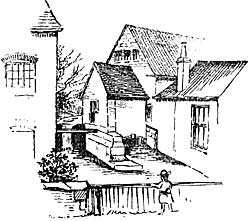 The old mill, Bulwell.
The old mill, Bulwell.Still well within a standing view from our market is the old village mill. Some of us still remember the old foot-bridge from the market to the church entrance in Church Lane. It was a series of large stone slabs five or six feet wide, without any side protection. As a boy I often wondered how drunken men managed to get across safely. On the other side, iron railings gave helpful access to the graveyard for old people as they mounted the incline. Traces of the old mill can easily be seen from the top of the bus; there is the dam and waterfall and the old cottage, now hemmed in in all directions.
The Bulwell wakes of old times have disappeared from the market place. It would take too much space to describe the old celebration, but we look back to it as an outstanding event in our boyhood calendar. I venture to mention the boiling of the ham in the copper and all the pantry extras; the friends and relations who came for the feast; the odd sixpences they sometimes gave to us youngsters, and the marvellous things one could get in those days with the nimble sixpence.
There is reason to believe that in remote days before our time a toll gate stretched across the entrance to what is now Commercial Road, previously known as Quarry Road, and before that Starr Lane—why "Starr" I do not know. On the left-hand corner, near the market, Walker's blacksmith's shop stood back some distance, and collected there for repair were all sorts of farming implements. On a dark night, when they were sharpening colliers' picks for the next day's toil, the glow of the furnace piercing the surrounding darkness, the brawny blacksmith in the firelight hammering the red-hot iron and making the sparks fly in all directions, made pictures in light and shade in my young mind which I shall never forget.
Now let us give a few lines to the back side of the market. There was the old "Horse and Jockey", still remembered by many, with its quaint old front facing the market, its cosy little rooms, and easy access, being in the centre of the village. The new erection is possibly more commodious, but the charm of the old structure has left a memory of its own. On the same side was the old "bonnet shop", now replaced by the bank. How many now can remember the garden fronting the market, with W. Faulconbridge's maltrooms, and the big old family residence where the picture-house now stands? We must get along and leave much out which it would be a pleasure to put in.
Further along towards the Wesleyan chapel were several old cottages, one of which sold butterscotch, bulls' eyes—and big eyes they were, actually tasting of butter and sugar, and no coupons.
Now let us go along Main Street some little distance. The old Bulwell name for Vere Street was "The Stackyard". The Starr Inn was inn and farm combined, and had its accommodation parts up Vere Street before the chapel was built. Gedling Street has a peculiar building which can be seen better from the next big old yard. This building was a new school before compulsory education. Some of our old townsmen were proud to be transferred from "dames' schools" to the new venture. It is now used as a storeroom.
Continuing, we come to the new Baptist chapel. The history of the Bulwell Baptists well pays for a little research. In 1805, Bulwell was described as a "big, scattered, neglected and God-forsaken village". At this time, a Mr. John Garton came to live at Bagnall in what was then known as Stump Cross Hall. Mr. Garton had the house licensed for preaching, and Baptist services were begun. The first Baptist chapel was erected near the present site about 1810, and afterwards converted into two cottages when the second chapel was built in 1827. The third chapel had no baptistery, and candidates had to be baptised at Hucknall, Basford, and in the River Leen. I have known old members who were baptised in the Leen down by the old mill, near the chapel. Let me mention here that, about 1850, sermons could be bought at twenty-six for sixpence. Candles were used in many chapels, to be followed by oil lamps and later by gas. The sexes were allowed to sit together in the gallery, but were separated downstairs—women on the right and men on the left.
The Leen was a hard-worked river for its size. Behind the Baptist chapel was Gamble's Mill, now demolished. There are a few now who remember it, and I had a drawing made for memory's sake by a student at our College of Art in Nottingham.
A little way down the Cinderhill Road is what is known as Charles's Bleachyard. With its back to the main road, the old residence still stands and provides accommodation for two families. A long time back, its lawns and gardens stretched down to the mill on the Leen. How old it was in 1814 I have no means of knowing; in that year it was transferred to Jane Lady Parkyns of Bunny Hall and two other persons. Lady Parkyns was the third wife of the son of the celebrated Sir Thomas Parkyns, boxer and wrestling champion. The house at that time was used as a shooting lodge for the Parkyns family and their visitors. From Bunny they used to come along, mounted on ponies. The main attraction was the snipe shooting along the Leen valley. In 1835, it was again leased to Dr. John Michael Davidson who, in addition to being a bleacher and calico printer, was the doctor at our Mapperley asylum. There is a statement on record that this mill was the first in the country to print patterns or designs on calico.
Across the road and up the drive is the lovely residence built by the late Edward Charles. It is worth while to notice what is left of the fine old gates at the entrance to the drive. In 1877, the Cinderhill toll bar was discarded; Mr. Charles bought it and placed it in its present position. One is saddened to see its decay, as work of this solid and artistic nature is not commonly constructed in these mass-production days. Let me add that Mrs. Foster, the daughter of the late Edward Charles, has a charming painting of the old mill-wheel which was in use till recent years.
We will now stroll back along Coventry Road. On our right, as we enter Bulwell, is Bradford Street, formerly known as Victoria Park. Why it was changed I do not know, but the older name was not just a popular place-name, because it appears on birth and marriage certificates. From Bradford Street to Commercial Road you will notice that all the thoroughfares run up to the railway, and only Hempshill Lane has a road bridge over it. Before the railway "was made, it would appear that the various roads merged into one which went over what is now fields on to the Nuthall Road. This part of Bulwell, with the Old Buildings and Robinson's Hill, can claim to be the oldest section of our town.
At the bottom of Stockwell Street is the old Church of Christ, 1847, afterwards the Templars' Hall. The Templars wore a bit of blue ribbon on their coats to indicate that they were teetotallers, and wished everybody to follow their example. Some did; a lot didn't.
